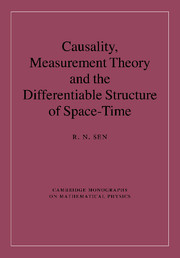Book contents
- Frontmatter
- Contents
- Preface
- Acknowledgements
- To the reader
- Prologue
- Part I Causality and differentiable structure
- Part II Geometrical points and measurement theory
- Mathematical appendices
- A1 Sets and mappings
- A2 The real number system
- A3 Point-set topology
- A4 Completions
- A5 Measure and integral
- A6 Hilbert space, operators and spectral theory
- A7 Conditional expectations
- A8 Fibre bundles, differentiable manifolds, Lie groups and Lie algebras
- List of Symbols for Part I
- References
- Index
A4 - Completions
Published online by Cambridge University Press: 04 August 2010
- Frontmatter
- Contents
- Preface
- Acknowledgements
- To the reader
- Prologue
- Part I Causality and differentiable structure
- Part II Geometrical points and measurement theory
- Mathematical appendices
- A1 Sets and mappings
- A2 The real number system
- A3 Point-set topology
- A4 Completions
- A5 Measure and integral
- A6 Hilbert space, operators and spectral theory
- A7 Conditional expectations
- A8 Fibre bundles, differentiable manifolds, Lie groups and Lie algebras
- List of Symbols for Part I
- References
- Index
Summary
There are many differences between the spaces ℝn and ℚn but the one we shall single out is that differentiable functions can be defined on ℝn but not on ℚn. It is this fact that invests the process of completion – i.e., passage from ℚn to ℝn – with so much interest.
A completion process requires more structure than topology. We have already discussed the Dedekind completion of the rationals, which is based on the concept of order and cannot be extended to sets that are not totally ordered. The most important class of spaces that can be completed are the metric spaces; a metric, as we have already noted, imposes more structure than a topology. Finally, there are the structures called uniformities, weaker than metrics but stronger than topologies, that can also be completed. Remarkably, the completion of uniform spaces, unlike that of metric spaces, does not require the explicit use of real numbers.
We shall discuss metric completion, uniformities and uniform completion in this appendix. A metric space can be completed in at least two different ways (with the same result); one can be generalized to uniform spaces, and the other cannot. We shall discuss only the former. Similarly, uniformities can be defined in at least three different but equivalent ways; we shall choose the one which is best adapted to generalizing the procedure of metric completion. The summaries given below will not provide balanced pictures of their subjects.
- Type
- Chapter
- Information
- Publisher: Cambridge University PressPrint publication year: 2010

